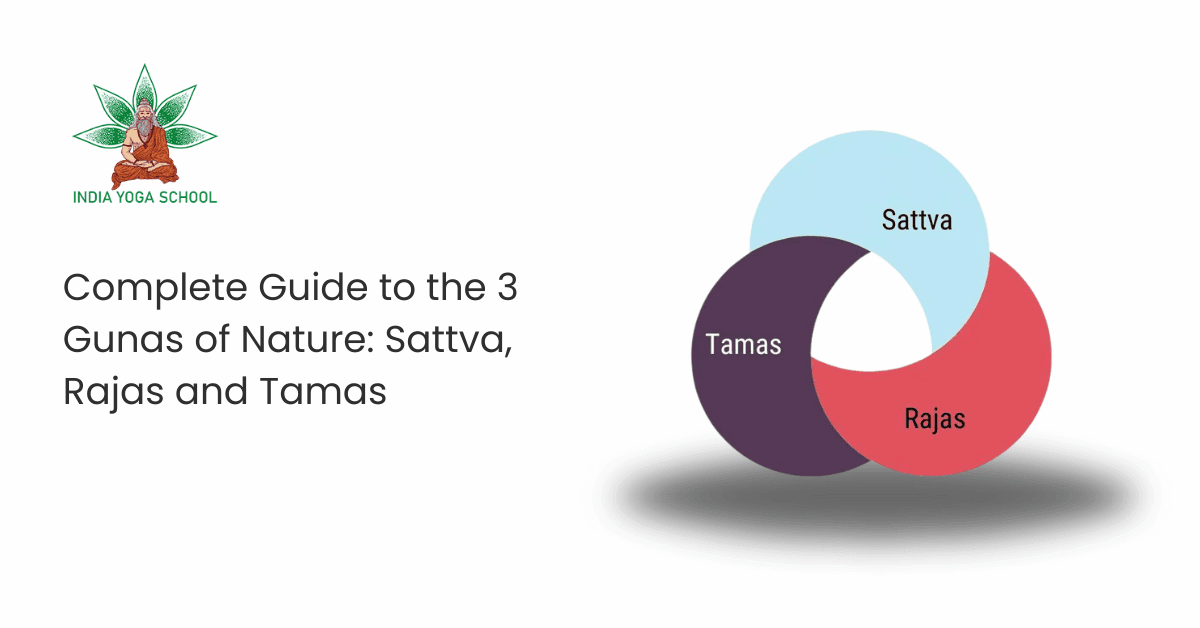According to yoga philosophy, the most basic substance in the cosmos is Prakriti, from which all other matter originates. All of nature’s fundamental components—energy, matter, and consciousness—emerge from this ethereal Prakriti as the three main gunas, or characteristics of energy.
- The tamas guna represents chaos and darkness.
- The rajas guna represents energy and passion.
- The sattva guna represents tranquilly and balance.
Balancing gunas is one of the many parts of a persons life we take care of At India Yoga School. Reducing stress, increasing inner calm, and leading one towards enlightenment are all possible through awareness and deliberate manipulation of the three gunas.
What are Gunas?
Guna is a word from Sanskrit that means quality, attribute, characteristic or tendency. As a tattva, or reality factor, guna influences our mental, emotional, and energy states in Ayurveda and yoga. Although the three gunas first emerged as central to Sankhya philosophy, they have since become an important idea throughout the majority of Indian philosophical traditions.
The three gunas are in a perpetual state of maya, or illusion, where they playfully interact with one another. The characteristics of an entity can be defined by the patterns of its guna interactions, which in turn can have a significant impact on one’s life trajectory.
When we practice yoga with an awareness of the gunas, it’s like having a personal guide that brings us closer to our destination; in this case, yoga balances all these gunas and makes us more balanced, calm, and harmonious in all aspects of our lives. One step closer to realising the oneness that is true for all beings is honing our capacity to recognise and comprehend the characteristics of the gunas.
Read: 6 Types Of Yogic Kriyas
Tamas, Rajas, and Sattva Gunas
No matter what we’re looking at, all things have some degree of all three gunas. One remarkable quality of the human species is the capacity for deliberate regulation of guna levels in the mind and body. The gunas are inherent and cannot be eliminated or separated from oneself, but they can be intentionally influenced to grow or shrink. Things outside of oneself, one’s way of life, and one’s ideas can all interact and impact one’s guna, either increasing or decreasing it.
What are the differences between the three gunas?
Tamas Guna
Tamas is characterised by heaviness, matter, darkness, and immobility. Ignorance gives rise to tamas, which in turn leads all living things astray from their inherent spiritual truths. Tamasic traits also include sloth, contempt, attachment, misery, powerlessness, uncertainty, humiliation, guilt, boredom, addiction, pain, melancholy, indifference, bewilderment, loss, dependence, and ignorance.
Rajas Guna
Being in a state of Rajas means being active, dynamic, changing, and moving. Because of its attractive, desiring, and attaching quality, rajas firmly ties us to the results of our labour. In addition to wrath and exhilaration, rajasic traits include anxiety, fear, irritability, restlessness, tension, bravery, contemplation, resolve, and disorder.
Sattva Guna
Intelligence, joy, balance, and harmony are the characteristics of sattva. Because it lessens rajas and tamas, sattva is the guna that yogis attain, allowing them to attain freedom. Additional sattvic traits include joy, contentment, serenity, health, independence, love, kindness, peace, empathy, friendliness, concentration, self-discipline, trust, fulfilment, serenity, thankfulness, courage, and selflessness.
Read: Complete Guide to the 7 Chakras and their Effects
Tips To Balancing The Gunas
A person’s mental state can shift wildly between the gunas, or aspects of mind. When we look at the world through the prism of our dominant guna, we see things differently.
- Yogis need to train themselves to be observers of their own actions rather than reacting to the gunas’ actions if they want to advance along the path.
- We need the inner fortitude and determination to make the deliberate transition from tamas and rajas to sattvic equilibrium and purpose.
Tips To Lower Tamas Guna
- Avoiding tamasic foods, excessive sleeping, excessive eating, laziness, passivity, and frightening events can help lessen tamas.
- Heavy meats and foods that have been ruined, chemically treated, processed, or refined are examples of tamasic foods.
Tips To Lower Rajas Guna
- To lower rajas, stay away from rajasic meals, excessive exercise, excessive effort, loud music, thinking too much, and material possessions.
- Fried food, spicy cuisine, and stimulants are all considered Rajasic.
Tips To Increase Sattva Guna
- Eat sattvic foods, engage in joyful activities, surround yourself with good people, and decrease rajas and tamas to boost sattva.
- Foods that are rich in sattvic energy include those that grow above ground, such as legumes and entire grains.
- Developing sattva in one’s mind and body is the ultimate goal of all yogic practices. That is why practicing yoga and leading a yogic lifestyle strongly promotes sattva.
Conclusion
All of the gunas connect the individual to their ego by causing attachment. One achieves enlightenment and is liberated from birth, old age, disease, and death when they transcend the three gunas that arise in the body. Although sattva is the end objective of yogic practice, the misidentification of self with the gunas and the consequent inability to separate oneself from the good and terrible aspects of life are the yogi’s ultimate aspirations. At India Yoga School, our yoga instructors can guide you toward a well balanced life through yoga. Visit us to learn yoga for a well balanced happy and healthy life.


Leave A Comment